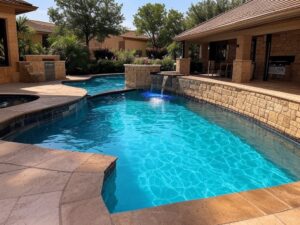To ensure a clean and fun bath, be it an Inground Pool or an above-ground one, the pool must be kept clean always. This guide well illustrates step by step how to clean an Inground Pool. This guide will talk about daily chores and weekly upkeep of the Inground Pool to get it in shape. If these steps are followed, pool owners can be certain that, under the rules, their pool will be in good condition for them and their families to have fun and relax.
Getting the Right Cleaning Tools
Before the start of clean an Inground Pool , see to it that you have everything you need. Be equipped with the following items:
- Pool skimmer net
- Pool brush
- Vacuum head and hose
- Long pole
- Water testing kit
- Pool chemicals (chlorine, pH adjusters, algae killer)
- Leaf rake (if necessary)
When all tools are on-hand, the cleaning process runs quickly and effortlessly. All tools serve different purposes in keeping the pool in a good and functional condition.
Removing Floating Debris
To start with, the clean an Inground pool process is in action by the removal of leaves, insects, and other objects floating on the water. This can be done using a skimmer net which is attached to a long pole. Skim the entire pool surface, including deep areas. Don’t forget about the corners and the places around the stairs, where stuff is usually piled up. This needs to be done every day, not missing any day so as to let the pool be clean and stop debris from falling down to the bottom.
Brushing For clean an Inground Pool Walls and Floor
After skimming, brush the walls and floor of the pool. Hence, it deletes algae, dirt, and other substances sticking to the surfaces. To the entire pool, attach the pool brush to a long pole to scrub through it. Begin from the starting end, and then, go through the deepest part. To cover the entire area, it is essential to use the unwinding strokes. Make sure to cleanse corners, stairs, and the most difficult-to-reach spaces. The brush job should be attended to every week so as to halt the algae and to have the surfaces of the pool always clean.
Vacuuming the Inground Pool
Vacuuming is the procedure that takes off the loose debris and the ones that sink are sucked up. The two main types of vacuuming an inground pool are explained here:
Manual Vacuuming
You can vacuum the pool through these ways:
- Join the vacuum head to the long pole.
- Fasten the vacuum hose to the vacuum head.
- Fill the hose with water to eliminate the air that is inside it.
- Attach the other end of the hose to the skimmer or the vacuum port.
- Again and again, the vacuum head moves across the pool floor in overlapping lines, very slowly.
- When the pump basket gets full, throw out the trash it catches.
Automatic Pool Cleaners
You might also go for an automatic pool cleaner if you prefer; three main kinds of these are there:
- Suction side cleaners: be connected to the pool’s filter system.
- Pressure-side cleaners: with a separate pump, they work.
- Robotic cleaners: do everything themselves.
Abide by the script given by the manufacturer on the procedures that you will use to install and operate automatic cleaners.
Clean An Inground Pool Filter
Water quality is dependent on a clean filter. This is how you can clean the filter based on the type you are using:
Sand Filter
BackwaTshing the filter will be needed when you notice an 8-10 PSI rise in the pressure gauge above the normal level. Backwash should go on for 2-3 minutes or until the water comes out clear. Next, rinse the filter in clean water for about 30 seconds so that the sand can settle.
Cartridge Filter
Detach the cartridge and then rinse it thoroughly with a hose. For a thorough cleanup, you can soak the cartridge in a cleaning solution. Take out the cartridge and replace it if it is completely worn off.
DE (Diatomaceous Earth) Filter
Backwashing such as a sand filter and adding DE powder as per the manufacturer’s instructions.
Testing and Balancing Water Chemistry
Sound water chemistry is the cornerstone of a clean pool. Employ a kit to analyze these fundamental grades :
- pH: It has to be 7.2 to 7.6.
- Chlorine: It has to be from 1 to 3 ppm (parts per million)
- Alkalinity: It has to be 80 to 120 ppm
- Calcium hardness: It has to be from 200 to 400 ppm
You can adjust the levels by using the chemicals that are appropriate for each situation. When using pool chemicals, make sure to follow the product label instructions.
Shocking the Pool
To stun the inground pool simply means to pour in a great deal of Chlorine into the water from where the water with its toxins will be cleared away. This way we can combat against the growth of germs that are brought into the pool by people who swim there. Here’s the way to do it:
- Check the pool water beforehand.
- Decide the right shock product that you will use.
- Apply the shock in the evening as directed.
- Activate the pump for at least 6 hours after shocking.
- Then you can go swimming until the levels measured again are 1-3 ppm.
Maintaining Proper Water Level
Good filtration happens when the water remains at approximately the center line of the skimmer opening. The water level on the skimmer must be kept at a constant level. You may need to add water, especially after having a lot of bathers or rain. If water is getting low quickly, examine for any leaks.
Regular Maintenance Tasks For clean an Inground Pool
Additionally, implement the following:
- Skim the surface on a daily basis.
- Brush the walls and floor at least once a week.
- Do the vacuuming of the pool weekly.
- With water chemistry, measure and adjust “chemistry” 2-3 times per week.
- Shock the pool every seventh day.
- Clean the filter if necessary.
- Check and clear skimmer and pump baskets weekly.
Seasonal Maintenance
As time goes by, the maintenance of the pool moves along with the shifting seasons:
Spring Opening
Once the pool has been opened after the winter season, it has a dewy start. But first, a study must be conducted, then, repair or replace the tools and finally, purify the water.
Summer Maintenance
Usually during the peak summer season, you have to clean more often and be regularly vigilant of the chemical levels. Dread the occurrence of the algae growth and deal with it promptly if it does occur.
Fall Maintenance
Continue to regularly look after your pool, but at the same time, concentrate on reaching every leaf that falls into the pool.
Winter Closing
Getting the pool winterized with the help of a renovation company that does all the required activities, such as cleaning thoroughly, balancing the water, lowering the water level, blowing the plumbing lines, and covering the pool.
Conclusion
Clean an inground pool or above-ground is a task that needs regular attention and precision. This is not only a comprehensive guide, but it is also a source of clear information that helps people with the operations of their swimming setups. Remember that not only does the regular maintenance just make the pool enjoyable for the bath, but also it facilitates the non-appearance of bigger problems and the magnification of the necessity for a big cleaning in the future.




